Disciplinary influences on research gap identification
Abstract
The article seeks to compare how linguistics and engineering scholars employ research gap identification (RGI) strategies by identifying their types, analyzing their supporting linguistic resources, and calculating their frequencies. Two sets of research article introductions, one for each discipline, were collected from ten Russian journals. To investigate the corpus and explore the RGI strategies, the research used a mixed-method approach. The analysis revealed that both linguistics and engineering writers employed all four types of RGI strategies – indicating a lack of research, highlighting insufficient research, acknowledging limitations, and emphasizing contradictions – though significant differences emerged in the frequency of their use and the accompanying linguistic features. The results show that while linguists, facing a less competitive publishing landscape, feel less pressure to aggressively critique existing research, engineering authors tend to point out problems or disagreements in previous studies to show why new methods, algorithms, or models are needed. The study also identified distinct patterns in the use of linguistic resources to signal research gaps, with linguistics research demonstrating a near-equal preference for verb and noun phrases, while engineering research introductions exhibited a stronger preference for verb phrases over noun phrases. These findings highlight the profound influence of disciplinary communities on researchers’ rhetorical practices. This knowledge can be applied to improve the effectiveness of academic writing instruction across disciplines, enabling students and researchers to better understand and strategically employ RGI strategies to enhance the persuasiveness and impact of their publications.
Keywords: Research gap, Research gap indicating strategy, Russian academic writing, Research article, Introduction
Introduction
Academic research is a systematic process of generating new knowledge and incorporating it into the existing body of knowledge within a specific discipline. A crucial step in this process is identifying a research problem. This involves pinpointing gaps in understanding a particular topic, highlighting areas where further investigation is needed to advance knowledge and insights (Wang et al., 2016). Highlighting a research gap effectively showcases the need for a new study and its potential contribution to the field. This process of identifying a gap and outlining its significance directly justifies the author’s research, demonstrating its relevance and value to the broader academic community. Beyond establishing credibility, RGI also plays a key role in framing the research discussion. By pinpointing a research gap, authors establish a clear context for their study. This sets the stage for formulating research questions and hypotheses, demonstrating how the presented research builds upon and expands existing knowledge. Additionally, a well-defined research gap helps differentiate the current study from previous work, highlighting the author’s unique contribution to the field. Furthermore, a compellingly articulated research gap can pique the reader’s interest, motivating them to delve deeper into the study’s findings and explore the potential implications of the research.
A significant body of research has focused on RGI strategies employed in English-language research articles (RAs) (Arianto et al., 2021; Chen, Li, 2019; Lim, 2012; Shehzad, 2012; Suryani et al.). For example, Shehzad (2008) conducted an in-depth analysis of various gap statement types used by computer scientists in RA introductions, providing valuable insights into how they articulate research gaps. Lim (2012) explored the rhetorical strategies and linguistic features used to demonstrate research novelty, highlighting the ways, authors can effectively showcase their unique contributions. Suryani et al. (2015) investigated the specific RGI strategies employed by Malaysian writers in the field of computer science, adding to our understanding of how disciplinary context shapes research communication. Additionally, Arianto et al. (2021) and Chen and Li (2019) have made significant contributions to this field, further expanding our knowledge of RGI strategies in English-language academic writing. Chen and Li’s (2019) study explored variations in learner writers’ niche-establishment practices in a Chinese context. They found that the less expert writers were more critical than their earlier counterparts. Arianto et al. (2021) made an attempt to compare the use of RGI strategies in English language teaching RA abstracts and introductions by Indonesian doctoral students, Indonesian academics, and international authors. Arsyad and Zainil’s (2023) study compared the ways of addressing the gaps in Applied linguistics RA introductions and revealed that the authors most frequently indicated inadequate research and contradictive/conflicting evidence to establish a RG.
While existing research on RGI strategies in English-language RAs has provided valuable insights, a notable gap exists in the literature regarding the use of these strategies in Slavic languages, particularly Russian. No empirical studies appear to have specifically examined RGI strategies employed by Russian authors in their academic writing. The literature review revealed that Slavic-language academic discourse has been predominantly analyzed in terms of self-mention markers (Bogdanović, Mirović, 2018; Boginskaya, 2022, 2024; Pyankova, 1994; Walková, 2018), move structures (Zanina, 2016, 2017), politeness markers (Larina, 2019; Larina, Ponton, 2020), evaluation strategies (Chernyavskaya, 2023), metadiscourse patterns, purpose and gap statements (Boginskaya, 2024; Duszak, 1994; Hryniuk, 2018; Warchał, 2018), rhetorical questions and persuasion strategies (Cmejrkova, 1996; Dontcheva-Navratilova, 2020), or detachment patterns (Vassileva, 2001). In view of the above mentioned gap, the present study is filling it by conducting an analysis on the Russian-language corpus to investigate how Russian writers from two fields of knowledge indicate a RG in RA introductions. The present study conducted on Russian materials can encourage scholars to explore RGI strategies in RAs written in other Slavic languages.
This study aims to compare how engineering and linguistics scholars utilize RGI strategies, addressing the following questions:
(1) Which RGI strategies are most common in linguistics and engineering RA introductions?
(2) Are there qualitative and quantitative differences in the way researchers from two disciplines signal research gaps?
(3) Do linguistic resources for indicating research gaps vary between engineering and linguistics?
Drawing upon earlier cross-disciplinary studies of academic writing (Boginskaya, 2022, 2023; Khedri et al., 2015; Kochetova, Kononova, 2018; Samraj, 2002; Stotesbury, 2003), this study proposes that Russian RA introductions written by scholars from two different fields will display contrasting approaches to research gap indication and linguistic resources.
The article begins by reviewing previous studies on RGI strategies in RAs. The next section presents the methodology and proceeds to the analysis and discussion of data. The article concludes with some observations on the role of RGI strategies and lexical items used for verbalizing them in linguistics and engineering RA introductions.
Literature review
Presenting a RG in RAs involves outlining the existing research area and identifying the research space that remains unexplored, aiming to persuade the reader of the necessity for further investigation. Swales (1990) considered the issue of RG in RAs as part of a model proposed for the RA Introduction section and comprised of three moves – “establishing a territory,” “establishing a niche” and “occupying a niche.” Each of these moves in the Swales’ model is further divided into a number of mandatory and optional steps. The second move offers four different strategies: counter-claiming, indicating a gap, question-raising, and continuing a tradition. (Swales, 1990) In his later study, Swales (2004) revised the second move by presenting it as a series of three steps – indicating a gap, adding to what is known, and presenting positive justification.
It is interesting that in the Swales’ model, indicating a RG is not considered to be an obligatory step in RA introductions. What is more, Fredrickson and Swales (1994) claimed that the low presence of the RGI step in RAs written in languages other than English is due to the lack of necessity to compete for research space because of the size of the discourse community. As Fredrickson and Swales (1994) put it, scholars writing in Swedish face competition for readership rather than in terms of research space. They posited that the smaller size and less competitive nature of some non-English discourse communities might not require authors to emphasize research gaps as strongly. In these contexts, the research community might already be aware of the gaps. Similar results were obtained by Taylor and Tingguan (1991), who found that Chinese scholars writing in Chinese tend to omit the RGI step. An absence of the RGI step was also observed in some other studies. Jogthong (2001), for example, revealed that 45% of the articles derived from Thai medicine and education journals lacked this step. Arvay and Tanko’s (2004) corpus of articles derived from English and Hungarian journals, 30% also lacked this step.
A number of other studies conducted on English-language materials regard this strategy as the one frequently used by writers (Anthony, 1999; Postegullio, 1999; Shehzad, 2012). Postegullio (1999), for example, claimed that the RGI strategy is the most preferred means of presenting the need for the work in computer science RA introductions. Anthony (1999), who explored engineering RA introductions, revealed that almost 92% of the writers indicate a RG. The similar results were obtained by Shehzad (2012), who found this step in 95% of the computer science RA introductions. The move analysis conducted by Suryani et al. (2015) on computer science RA introductions found that 73% of the RAs by Malaysian writers have employed the RGI strategy. They concluded that this step, being a crucial part of the Introduction, was underused in the RAs selected to build the corpus.
Studies on the RGI strategy in RA introductions include research conducted by Lim (2012), Müller-Bloch and Kranz (2015), Chen and Li (2019), Arianto et al. (2021), Arsyad and Zainil (2023). Lim (2012), for example, aimed to demonstrate how the novelty of a new management study is presented by analyzing the rhetorical steps and supporting linguistic features used in indicating RGs. Chen and Li (2019), who used the term “niche establishing attempt” to refer to an instance when the writer evaluates the previous research and presents RGs, examined RGI strategies in Chinese learners’ thesis’ literature review chapters from a diachronic perspective and revealed that the novice writers were discursively more critical than their more experienced counterparts. Arianto et al.’s (2021) study, conducted with the aim of comparing the use of RGI strategies in English Language Teaching RA abstracts and introductions by Indonesian doctoral students, Iranian academics, and international authors, suggested a five-component framework for identifying RGI strategies in RAs. The authors revealed that the Indonesian doctoral students and Iranian scholars used only one type of RGI strategy (highlighting the absence of research on the topic), which was explained by the impact of two factors: a lack of understanding of how to criticize previous research and cultural values that put a priority on respecting others and avoiding negative evaluations.
The debate surrounding the nature of RG statements in RA introductions highlights the complex nature of academic communication. It underscores the need for contextual awareness and careful consideration of audience expectations when framing research. The observations of the previous studies point to the importance of recognizing both cross-disciplinary and cross-cultural variations in academic discourse and the ongoing need to refine and adapt models of research article writing to reflect these differences.
A comparative analysis presented below will enable us to see differences and similarities in the use of RGI strategies by Russian authors. It would be interesting to see how often Russian scholars from two fields of knowledge use these strategies and what types of RG they present in their papers. The findings could contribute to a better understanding of research communication practices within Russian academia.
Materials and methods
This study examined the introductions to RAs in 10 prominent Russian journals, five in engineering and five in linguistics. Several criteria influenced the selection of these journals, all of which contributed to the rigor and generalizability of the findings. First, great quality and international recognition were necessary. To provide credible and meaningful data, only journals ranked Q1 or Q2 by Scopus were selected. This score suggests that the journals use rigorous peer-review processes and publish research that has a substantial impact on their respective fields, ensuring that the assessed RAs are high-quality examples of academic writing within their subjects. Second, direct relation to the study's disciplinary focus was required. The journals chosen specifically publish research in engineering and linguistics, resulting in a targeted dataset for comparing and evaluating writing patterns across both domains. This disciplinary specialization clearly addresses the research question of how field-specific norms affect the use of RGI strategies. Third, open access was critical to assuring the study's feasibility and replicability. The open access nature of the journals meant that all selected articles could be easily downloaded and evaluated, allowing for transparent and verifiable data collecting.
The choice of engineering and linguistics as disciplines for this study is a deliberate approach to highlight the stark differences in writing standards that divide the hard and soft sciences. Engineering, which is frequently distinguished by its emphasis on precision, objectivity, and direct communication, values clear articulation of process and results. Linguistics, which is connected with the humanities, favors more sophisticated arguments, interpretive frameworks, and a higher recognition of subjectivity. These disparities in discipline epistemology and communication styles are quite likely to influence writers' rhetorical choices, particularly their employment of RGI strategies. Additionally, this research builds upon previous studies that have demonstrated that academic writers are social actors who adhere to the norms and conventions of their respective disciplines and need to ratify their claims in order to obtain collective agreement that their data represent facts rather than opinions (Berkenkotter, Huckin, 1995; Hyland, 1998). This assumption underlies the current study’s exploration of how disciplinary norms shape RGI strategies in engineering and linguistics.
Having identified the target journals, 340 RAs (N = 340) were selected from ten journals in the two fields to ensure a good degree of objectivity and comparability of texts. To ensure a focused analysis of contemporary academic discourse, this study only included RAs from the most recent issues of each journal, published between 2020 and 2024. This approach minimized the impact of the publication period and provided insights into the linguistic features of present-day academic writing. Furthermore, to control for individual writing styles, only one RA per author was selected. Additionally, all the included RAs were organized into clearly labeled sections, with the introductions specifically identified. Table 1 illustrates the size of the corpus.
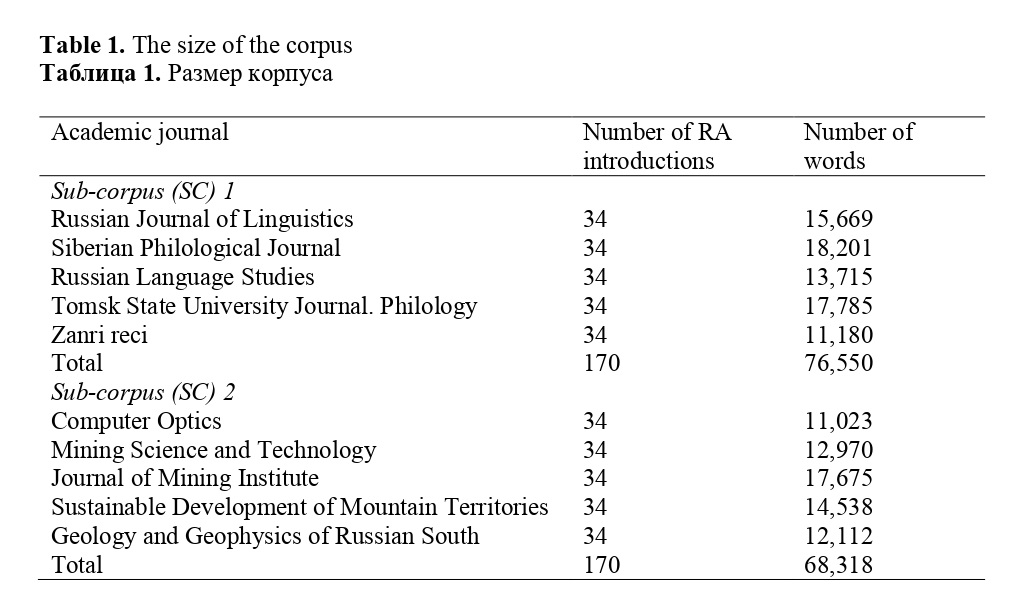
To compare the use of RGI strategies in Russian RA introductions written by engineering and linguistics scholars, this study adopted a mixed-method approach combining quantitative and qualitative analyses. The RA introductions were downloaded from the journals’ websites and converted to Microsoft DOCS format for analysis. The analysis focused on identifying RGI strategies and the supporting linguistic features employed to signal the research gaps. This qualitative analysis was further developed by performing a move analysis on the corpus of engineering and linguistics RA introductions. The move analysis was based on the CARS model (Swales, 2004) as the construct. The focus was on only one step of Move 2 – indicating a RG. Each word, phrase, and sentence in the introductions was carefully analyzed to identify any cue that relates to this step. The inter-group contrastive analysis was conducted to find potential similarities and differences between the groups.
A careful qualitative analysis of the context was conducted to classify RGI strategies by their types and to interpret differences revealed in the use of these strategies in the sub-corpora. To ensure in-depth exploration into the use of RGI strategies by authors from the two fields of knowledge, examples were taken from the corpus being studied and explanations were provided. Supporting linguistic features were analyzed and grouped into three structural categories: noun phrases, verb phrases, and adverbial phrases. Core lexical items used in each category were identified and calculated for each sub-corpus. The results were summarized in a table format.
For the purpose of the study, Lim’s model of RGI strategies was chosen as being focused on RA introductions rather than abstracts and literature reviews. Lim (2012) suggested a taxonomy including four types of RG: lack of research (when a research area is entirely unexplored or virtually untouched), insufficiency of research (when a topic has been investigated, but the research is limited in scope or depth), limitations of previous research (when there are shortcomings from previous studies, such as in methodology, terminology, classification), or contradictions in previous research (when there are contradictions, inconsistencies, or unresolved debates within the existing literature). The model is presented in Table 2.
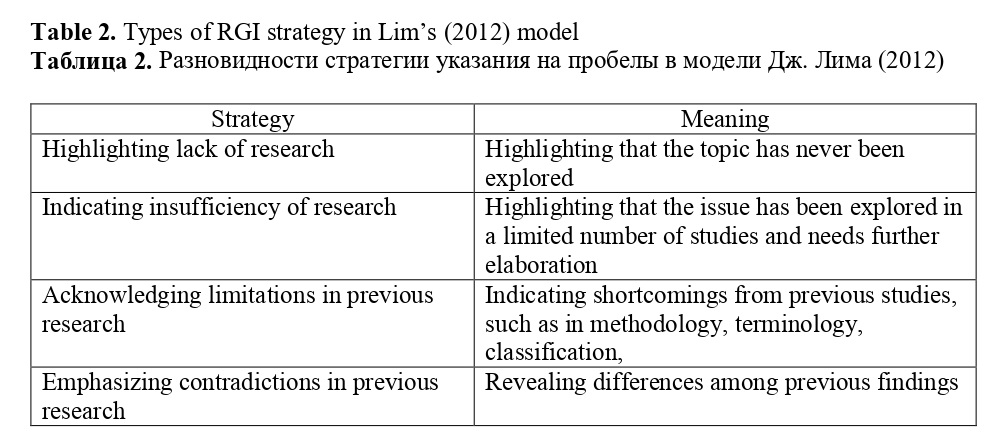
The choice of Lim’s (2012) typology of RGI strategies, focusing specifically on RA introductions, is justified because it provides a tailored framework for analyzing how research gaps are articulated in a crucial section of academic writing. Unlike models designed for analyzing abstracts or literature reviews, Lim’s framework offers a nuanced lens for examining the specific ways in which scholars position their studies within existing knowledge. This four-part taxonomy offers a comprehensive yet manageable set of categories for identifying and classifying the gaps authors employ to establish the novelty and significance of their research.
Findings
Frequencies of RGI strategies. The analysis revealed that a majority of both linguistics (63%) and engineering (78%) RA introductions utilized the RGI strategy. The frequencies of occurrence of the four types of RGI strategy are presented in Table 3.

Table 3 reveals that engineering RA introductions employed a wider range of RGI strategies compared to those found in linguistics introductions. This discrepancy is particularly pronounced in the use of strategies that acknowledge limitations and emphasize contradictions. Like in the previous study (Boginskaya, 2024), linguistics RA introductions tended to focus more on pointing out the complete lack or not enough research on certain topics. Also, they often combined different strategies to indicate research gaps, which happened more in linguistics.
Lexico-grammatical classification of RGI phrases. The study revealed distinct patterns in the use of linguistic resources to signal research gaps in the introductions of engineering and linguistics RAs. Table 4 categorizes the phrases identified in the two sub-corpora for analysis, providing insights into the distinct linguistic features employed by authors in these disciplines to highlight research gaps.

As evidenced in Table 4, the frequencies of verb phrases and noun phrases are nearly equivalent in SC1. In SC2, the verb phrases were more frequent than noun phrases. The adverbial phrases were least frequently used in both sub-corpora.
Lexical cores of the RGI phrases. The analysis also identified the most frequent lexical items used as a core of noun, verb and adverbial phrases indicating research gaps. Figures 1 and 2 summarize the results.

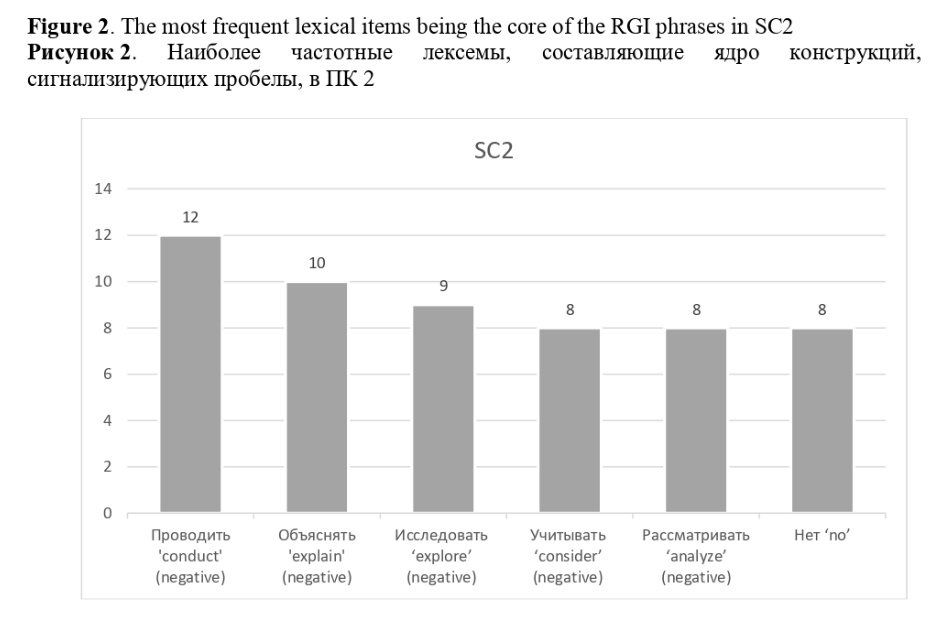
The figures show that the most frequent lexical items used as a core of the RGI phrase were the verbs проводить ‘conduct’, рассматривать ‘analyze’, изучать ‘study’, исследовать ‘explore’, учитывать ‘consider’, объяснять ‘explain’ in their negative form; the verbs отсутствовать ‘be absent’; the adverbs недостаточно ‘insufficiently’ мало ‘few’; the nouns необходимость ‘need’, разногласия ‘contradictions’, противоречия ‘discrepancies’; the adjectives немногочисленный ‘scant’, противоречивый ‘contradictory’, дискуссионный ‘debatable’; the particle нет ‘no’. The frequencies of these items were also different in the two sub-corpora.
Highlighting the lack of research. Authors can effectively highlight research gaps by indicating that no prior studies have been conducted on a specific area of inquiry. This strategy explicitly indicates a complete lack of research on the topic, emphasizing the need for new investigations. The strategy is predominantly realized through the use of negative quantitative noun phrases (e.g., небылоисследований ‘there were no studies’) or negative investigative verb phrases (e.g., неисследовались/have not been explored, неподвергалисьанализу ‘have not analyzed’, etc.) (Boginskaya, 2024). The corpus analysis revealed that the linguistics writers used this strategy more often than their peers from the engineering fields.
(1) Кроме того, изучения особенностей подобных тестов не проводилось. (SC1) [Moreover, features of the material of such tests have not been studied].
(2) Анализ литературы показывает, что на русском языке отсутствуют работы, которые бы полно охватывали данную тематику. (SC2) [The analysis of literature shows that there are no Russian-language review works that would rather fully cover this topic].
The examples point to a gap in research, with writers claiming that no studies exist on the linguistic features of stimulus materials or comprehensive reviews of the problem being investigated. While the RGI strategy in (1) is achieved through the use of a negative verb phrase, in (2) the writer employs a positive verb phrase отсутствуютобзорныеработы ‘there are no review works’.
The analysis revealed that negation was the most common linguistic feature used by the writers from both groups to indicate the lack of research. Here are some more examples from SC1 where the writers indicate the complete absence of research using the negative investigative verb phrases:
(3) Виды юридической коммуникации в массмедиа еще не выступали объектом лингвистического исследования. (SC1) [Forms of legal communication in the media have not yet been the object of linguistic research].
(4) Сильные аберрации не рассматривались в предыдущих исследованиях. (SC2) [Strong aberrations have not been considered in previous studies].
This example demonstrates an RGI strategy using the positive verb phrase оставатьсявстороне ‘be disregarded’ to emphasize the absence of research on elite culture in linguistics.
(5) Элитарная культура, культура интеллигентской прослойки в лингвистических исследованиях остается в стороне. (SC1) [Elite culture, the culture of the intelligentsia stratum, remains on the sidelines in linguistic research].
While the RGI verb phrase in SC1 оставатьсявстороне ‘be disregarded’ was relatively infrequent in the corpus (appearing only twice), a synonymous verb phrase was found in SC2, also used to highlight the lack of research.
(6) Гранатиты, широкое распространение которых среди эклогитов Слюдяной Горки было отмечено еще одним из первых исследователей эклогитов Полярного Урала Н.Г.Удовкиной [22], остались вне изучения во всех последующих работах. (SC1) [Granatites, the widespread occurrence of which among the eclogites of Mica Gorka was noted by another one of the first researchers of the eclogites of the Polar Urals N.G. Udovkina [22], remained unstudied in all subsequent works].
Within the context of the corpus, this verb phrase appeared only once, making it a unique instance. In contrast to the infrequent occurrence of this phrase, phrases with the negative predicate нет ‘absent’ (7) were significantly more common in both SC1 and SC2 (10 and 8 occurrences, respectively).
(7) Исследований лексикона учебников по русскому языку нет. (SC1). [There are no studies of the vocabulary of textbooks on the Russian language].
Table 5 shows the most frequent linguistic features that indicate the complete absence of research in a specific area.
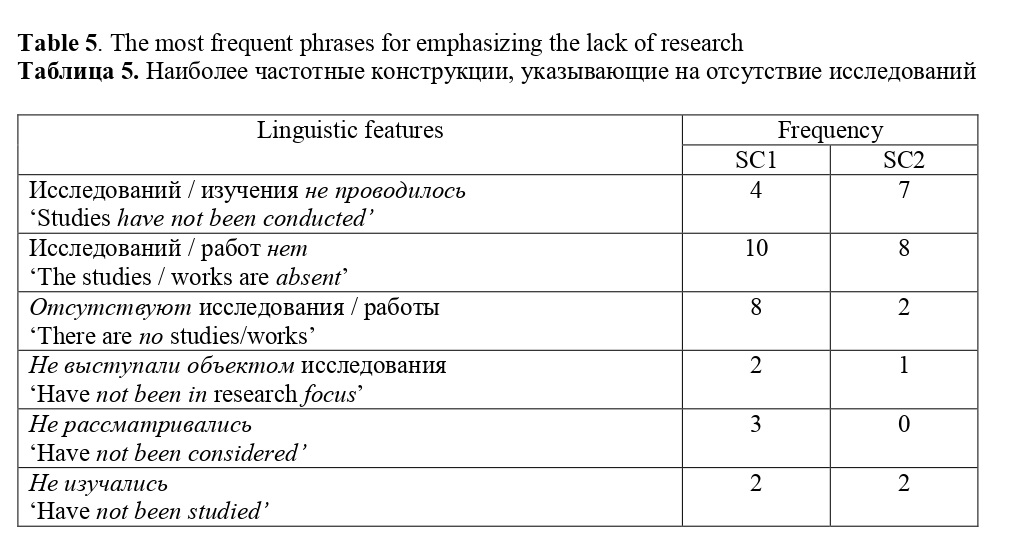
Table 5 shows that the existential predicate нет ‘no’ was most frequently used by the writers from both fields of knowledge. The second most common marker in SC1 was the verb отсутствовать ‘be absent’ used in the noun-phrases. The engineering writers preferred the negative phrase with the passive investigative verb проводить ‘conduct’ as a core lexical item.
Indicating the insufficiency of research. A research gap can emerge when the number of studies on a specific area is insufficient to draw definitive conclusions about the issue under investigation. Similarly, if the data collected in previous studies is inadequate to support robust conclusions, a research gap exists. This type of gap, highlighting the need for more data or a larger sample size, was more prevalent in the introductions of linguistics RAs than in those from engineering. Here are three examples from the corpus.
(8) Это обусловливает необходимость продолжения исследований в этой области. (SC1) [This fact determines the need to continue research in this area].
(9) Однако в целом исследования жанрово-дискурсивной обусловленности концептуального содержания немногочисленны. (SC1) [However, in general, there are few studies of the genre-discursive conditionality of conceptual content].
(10) Проблема заключается в недостаточном теоретическом и экспериментальном обосновании процесса осаждения твердых частиц в межпластинных каналах. (SC2) [The problem lies in the insufficient theoretical and experimental substantiation of the process of deposition of solid particles in interpolate].
(11) Однако этот вопрос недостаточно изучен из-за отсутствия корректных методов исследования процесса, что является серьезным препятствием для совершенствования данных технологий. (SC2) [However, this issue has not been sufficiently studied due to the lack of correct methods for studying the process, which is a serious obstacle to improving the technologies].
The writers indicate the insufficiency of research in a specific area by emphasizing the need to continue studies of the phenomenon (8), highlighting a small number of studies on the topic (9), showing the insufficiency of theoretical and experimental explanations of the process (example 10) or studies on the topic (11).
Most of the linguistic features used to realize this type of RGI strategy were noun phrases. Both corpora also featured adverbial phrases with the adverbs недостаточно ‘insufficiently’ and мало ‘few’. Table 6 shows the most frequent phrases stressing insufficient research on a specific area.
Table 6. The most frequent phrases for highlighting insufficient research
Таблица 6. Наиболее частотные конструкции, указывающие на недостаточность исследований
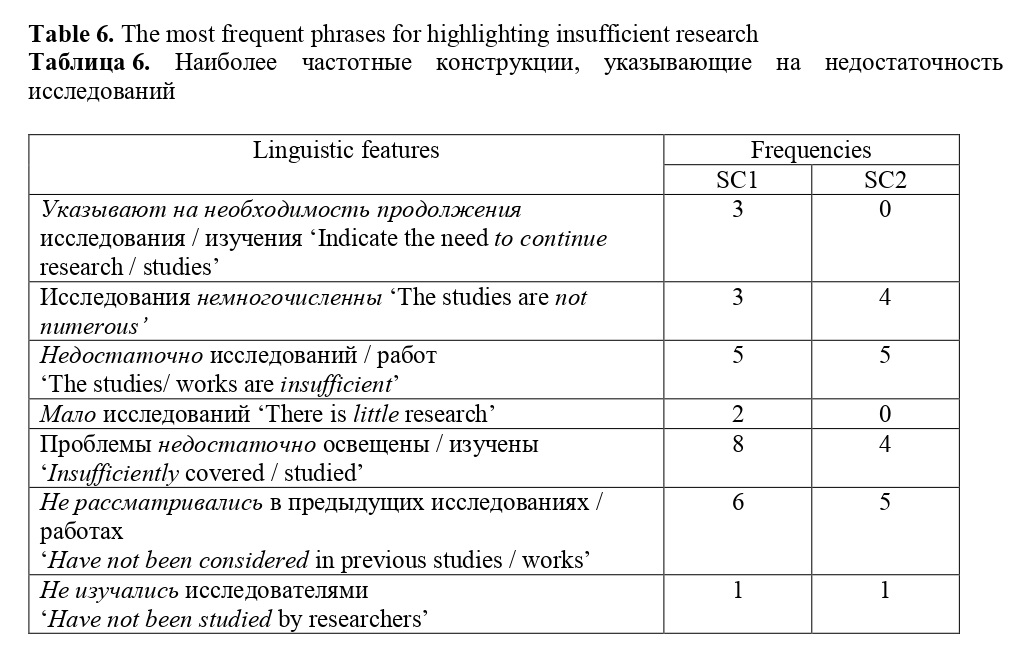
As can be seen from the table, недостаточно ‘insufficiently’ in the adverbial and noun phrases is the most popular marker used to realize this strategy both in SC1 and SC2. The second marker frequently employed by the writers was the negative verb рассматривались ‘considered’.
Acknowledging limitations in previous research. When authors seek to introduce a new method, concept, or model, they should carefully examine previous studies, focusing on their methodological limitations. Such limitations can arise from flaws in research design, insufficient sample sizes, or resource constraints. Our analysis of a corpus of engineering and linguistics RA introductions revealed that a significant portion of Russian authors highlighted methodological shortcomings of previous studies, as illustrated in the examples below.
(12) Однако в большинстве работ представлено узкое понимание профессионального дискурса. (SC1) [However, most well-known works provide a narrow understanding of professional discourse].
(13) Расчёт ФРТ гиперспектрометра в работах [7, 8, 12] не учитывает последовательность дифракции световой волны на элементах гиперспектрометра (апертурной диафрагме объектива, щели и элементах спектрометра) в соответствии с физикой формирования изображения. (SC2) [The calculation of the PSF of a hyperspectrometer in [7, 8, 12] does not take into account the sequence of diffraction of a light wave on the elements of the hyperspectrometer (lens aperture diaphragm, slit and spectrometer elements) in accordance with the physics of image formation].
(14) Однако метод имеет недостатки: трудоёмкость расшифровки интерферограмм, чувствительность измерительной аппаратуры к вибрациям, а также необходимость физического наличия эталонного волнового фронта. (SC2). [However, the method has disadvantages: complexity of deciphering interferograms, sensitivity of the measuring equipment to vibrations, and the need for the physical presence of a reference wave front].
In (12), the author critiques the narrow definition of “professional discourse” presented in prior studies. This critique aims to justify the need for a more comprehensive definition, addressing a methodological shortcoming identified in previous research. The strategy employed is achieved through the use of a passive voice verb phrase followed by a noun phrase, effectively highlighting the limitation of previous research and emphasizing the need for a broader perspective. In (13) and (14), the writers explicitly indicate drawbacks of the methods employed in previous studies with the negative form of the verb учитывать ‘consider’ and the verb phrase иметьнедостатки ‘have disadvantages.’ Table 7 shows the most frequent phrases used to reveal limitations in previous research.
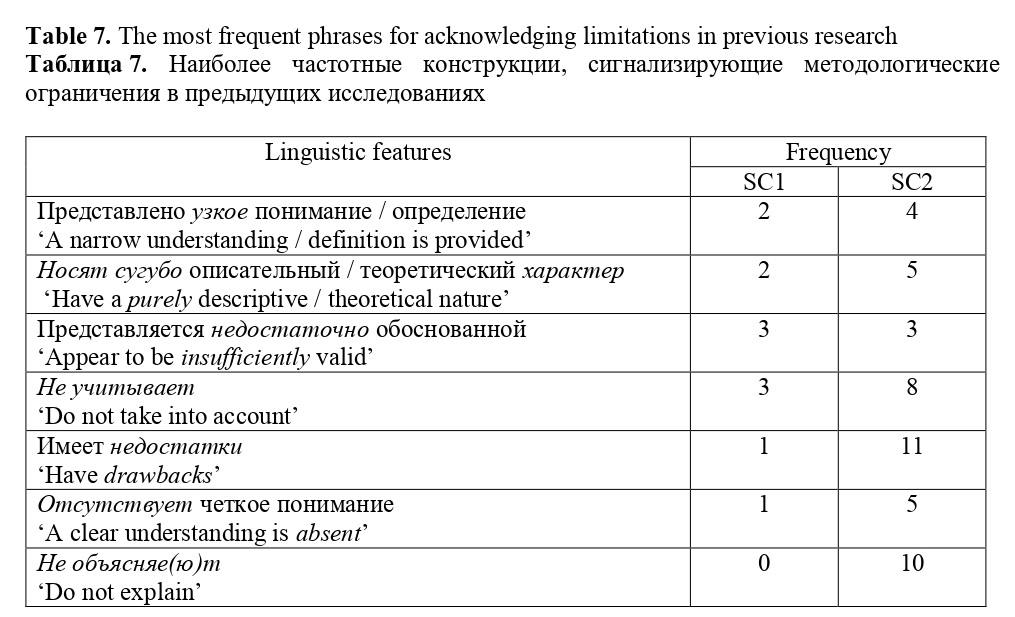
As is demonstrated in Table 7, the verb phrase иметьнедостатки ‘have drawbacks’ and the negative form of the verb объяснять ‘explain’ are two most frequent linguistic resources used for acknowledging limitations in previous studies by the engineering authors. The linguistics researchers exploited the verb phrase представляетсянедостаточнообоснованной ‘appear to be not valid enough’ and the negative form of the verb учитывать ‘consider’ more often than other phrases.
Emphasizing contradictions in previous research. When previous studies on a particular topic yield inconsistent findings, it signals a need for further exploration to reconcile these discrepancies. Identifying and presenting these contradictions constitutes a valuable RGI strategy. Highlighting the inconsistencies in prior research effectively justifies the need for a new study, underscoring the importance of addressing these unresolved issues and seeking a more comprehensive understanding of the topic. Here are some examples from the corpus.
(15) Однако выводы исследователей противоречивы. (SC1) [However, the researchers' conclusions are contradictory].
(16) Однако исследователи расходятся в оценке обоснованности данной классификации. (SC2) [However, researchers disagree on the validity of this classification].
(17) Однако исследователи расходятся во мнениях относительно того, можно ли говорить об абсолютной сложности языка. (SC2) [However, researchers disagree on whether it is possible to talk about the absolute complexity of language].
(18) Нет единого мнения о природе данного явления. (SC1) [There is no consensus on the nature of this phenomenon].
(19) Природа происхождения гранатитов до сих пор остается дискуссионной. (SC2) [The origin of garnetites is still controversial].
(20) Подходы к самой локализации разнятся (SC1) [Approaches to localization itself vary]
This type of RGI strategy is linguistically realized through the use of verb phrases and noun phrases with core components such as расходиться ‘differ’, дискуссионный ‘debatable’, противоречивый ‘controversial’, единый ‘single’ preceded by the negative particle нет ‘no’. Only in (18), the negative connotation is realized through the negation. In other examples, the writers use lexical items, whose semantics shows contradictive or conflicting previous research findings. Table 8 shows the most frequent phrases used to emphasize contradictions in previous studies.
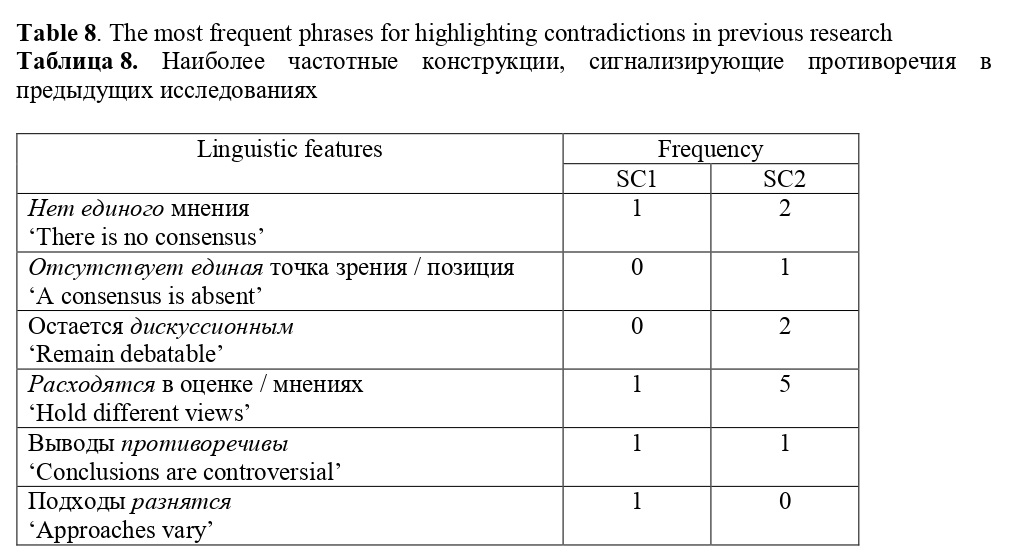
Table 8 indicates that the most frequent linguistic feature used by the engineering writers was the verb phrase расходитьсявооценке / мнениях ‘hold different views.’ The linguistics subcorpus yielded only three linguistic resources for this strategy: two noun phrases and one verb phrase, each appearing once.
Combining strategies. A powerful strategy involves combining multiple RGI approaches, such as highlighting a lack of research and acknowledging limitations in previous studies. This comprehensive approach demonstrates a thorough understanding of the existing literature and effectively establishes the need for further investigation. By combining different strategies, you can create a more persuasive and well-rounded argument for the need for your work, contributing to a more robust and compelling research project. However, this strategy was not frequent in the corpus (seven occurrences in SC1 and 2 occurrences in SC2). Here are two examples from the corpus.
(21) Несмотря на интерес к разным альтернативным источникам энергии, исследований их использования в металлургии до сих пор не было. Более того, изучение альтернативных источников осуществляется исключительно с помощью методов моделирования. (SC2) [No studies have specifically examined the use of energy sources in metallurgy, despite growing interest in this area. Previous research on energy sources has been limited by modelling methods, creating a need for new investigations.]
(22) Однако подобные попытки несистемны и часто недостаточно теоретически обоснованы, ибо фокусируются на проведении эксперимента и противоречиях в полученных данных, но не на архитектуре исследовательской парадигмы. (SC1) [However, such attempts are unsystematic and often not sufficiently theoretically substantiated, since they focus on the experimenting and contradictions in the data rather than on the architecture of the research paradigm.]
Combining two RGI strategies – highlighting a lack or insufficiency of research and acknowledging limitations in previous studies – is highly efficient because it creates a more compelling and comprehensive argument for the need for your research. The author builds a stronger argument for the need for further investigation.
Discussion
This study offers novel insights into the disciplinary variations of RGI strategies in Russian RA introductions from engineering and linguistics, exceeding prior research in several key ways. While previous research has acknowledged the influence of disciplinary norms on academic writing, this research quantitatively and qualitatively demonstrates the extent of this influence in the specific context of Russian RA introductions, revealing distinct patterns in the frequency, distribution, and linguistic realization of RGI strategies across linguistics and engineering.
This study revealed different patterns in the use of RGI strategies and supporting linguistic features in the introductions of Russian RAs from engineering and linguistics disciplines. The findings suggest a significant influence of the disciplinary communities on rhetorical practices, highlighting the need for authors to follow discipline-specific writing conventions. Swales (1990), Posteguillo (1999), Khedri et al. (2015), and Berkenkotter and Huckin (2016) similarly emphasized that different disciplines have unique writing conventions and expectations, shaping how information is presented, the arguments made, and the language used, and provided valuable perspectives on how disciplinary norms influence the organization, argumentation, and language used in academic writing.
While the two sub-corpora under study shared some similarities in their use of RGI strategies, the differences between them were more pronounced. First, the study showed that both groups of authors used all four types of RGI strategies in their introductions: indicating lack of research, highlighting insufficient research, acknowledging limitations in previous studies, and emphasizing contradictions in previous research. So, from this perspective, they seem to be adopting similar approaches to indicate research gaps. Second, the study revealed that the engineering RA introductions featured more RGI strategies, and the distributions of the types were also different in the two sub-corpora. The analysis found the RGI strategies only in 63% of the linguistics RA introductions. The share of the engineering RA introductions using these strategies was higher – 78%. The increased use of RGI strategies among engineering scholars could be explained by the highly competitive nature of the field in Russia, where ongoing advancements in materials and equipment production have led to a greater number of researchers seeking publication. The contrasting approaches to indicating research gaps in Russian linguistics and engineering could be also explained by the differing levels of competition within these fields. The less competitive nature of Russian linguistics may result in a decreased emphasis on critiquing prior research to secure publication, as compared to the more competitive environment within engineering. Linguistics scholars may have a less intense competition, allowing for more theoretical explorations and focusing on contributing to the advancement of theoretical frameworks without needing to emphasize practical implications, or identifying and exploring areas where existing research is limited. Linguistics authors tend to focus on saying that there was not enough research or no research at all on specific topics. Engineering authors, on the other hand, often point out problems or disagreements in previous studies, and they use this strategy to show why new methods, algorithms, or models were needed. Highlighting gaps in current methods, models, or technologies is an efficient way to justify new solutions. Third, the analysis revealed distinct patterns in the use of linguistic resources to signal research gaps in the introductions of engineering and linguistics RAs. SC1 displayed a near balance between the use of verb phrases and noun phrases. However, SC2 exhibited a greater preference for verb phrases over noun phrases. Both sub-corpora demonstrated a significantly lower frequency of adverbial phrases. The analysis also identified the most frequent lexical items used as a core of noun, verb, and adverbial phrases indicating research gaps. As can be seen from Table 5, the frequencies of these items were also different in the two sub-corpora.
The finding that engineering RA introductions exhibit a significantly higher prevalence of RGI strategies compared to linguistics introductions is particularly noteworthy. This challenges the assumption of a universal approach to establishing RGs and suggests that disciplinary competitiveness, specifically the intensified publication landscape in Russian engineering, shapes authors’ rhetorical choices. Furthermore, analyzing the linguistic resources employed to communicate RGI strategies yields detailed insights into each discipline's stylistic preferences. The contrasted balance of verb and noun phrases in engineering versus linguistics, together with the identification of the most frequently used lexical items, provides a clear picture of how both disciplines rhetorically build and accentuate RGs. In essence, this study breaks new ground by revealing the specific mechanisms by which disciplinary norms influence the rhetorical and linguistic construction of RGs in Russian RA introductions, emphasizing the critical need for authors to strategically adapt their writing to meet the expectations of their disciplinary communities.
Limitations. It should be admitted, however, that the research results presented in the article are limited due to several reasons. First, it is the small size of the corpus which indicates that the results should be understood only as trends in two disciplines. The findings can be confirmed by a large-scale cross-disciplinary study. Second, the study only uses RAs from ten Russian journals. This limits the generalizability of the findings to other languages or publication contexts. The rhetorical strategies used in Russian journals might differ from those used in international English-language journals. Third, the study focuses solely on linguistics and engineering. The findings might not be applicable to other disciplines with different writing conventions and research cultures. Fourth, within linguistics and engineering, there might be variations in writing conventions across different sub-disciplines. The study may not fully cover these nuances.
Conclusion
RGI is a rhetorical tool that allows authors to position their research effectively within the existing scholarly context. By strategically highlighting the gap and demonstrating the significance of their studies, authors can create a compelling case for their research, effectively communicate the significance of their work, justify the need for further investigation, and contribute meaningfully to the advancement of their field. The present study aimed to explore the use of the RGI strategies by Russian authors from engineering and linguistics in order to shed light on how disciplinary communities influence the pragmatic choices of academic writers. The analysis revealed that the authors from both fields used all four types of RGI strategies in a different way and with different frequencies. The study showed that the authors from both fields of knowledge articulated that no prior research had been conducted on a specific topic or area of inquiry, indicated insufficiency of studies, and pointed out limitations, inconsistencies, or contradictions in previous research. Combining multiple RGI approaches, such as highlighting a lack of research and acknowledging limitations in previous studies, was also used in the RA introductions. This comprehensive approach demonstrates a thorough understanding of the existing literature and effectively establishes the need for further investigation.
The increased use of RGI strategies in engineering research introductions suggests that the field’s competitive environment may incentivize researchers to demonstrate the unique value and novelty of their work. Russian linguists, facing a less competitive publishing landscape, felt less pressure to aggressively critique existing research. This contributed to the distinctive approach they adopted in identifying research gaps. While similar to the previous study, the most frequent strategies used by the linguistics writers were indicating the complete absence of research or insufficient research on a specific area, the engineering scholars predominantly indicated research gaps by acknowledging limitations or emphasizing contradictions in previous research, thus justifying the need for a new method, algorithm, or model. The analysis also revealed significant differences in supporting linguistic resources used in the engineering and linguistics RA introductions to indicate RGs.
The results of the present study constitute new information about differences in the use of RGI strategies by Russian scholars from two fields of knowledge – linguistics and engineering. Further research involving more disciplines would be required to verify findings on cross-disciplinary variations in the use of RGI strategies in RAs. It would be interesting to compare the use of the RGI strategies by Russian scholars in their Russian and English texts. In this way, we will be able to reveal to what extent Russian authors follow international academic writing conventions regarding the identification of a RG in academic discourse. Diachronic variation in the use of RGI strategies could also be of interest.
This research suggests that academic writing teaching materials should consider the distinct rhetorical practices and writing conventions of different disciplines. The findings emphasize the need to recognize the differential effects of disciplinary communities on academic writing.


















Reference lists
Anthony, L. (1999). Writing research article introductions in software engineering: How accurate is a standard model? Professional communication, IEEE Transactions, 42 (1), 38–46. https://doi.org/10.1109/47.749366(In English)
Arianto, A. Saukah, A., Basthomi, Y. and Wulyani, A. (2021). Previous studies have several limitations …: Indonesian doctoral students’, Indonesian academics’, and international authors’ research gap strategies in ELT research article abstracts and introductions, Journal of Language & Education, 7 (2), 25–44. https://doi.org/10.17323/jle.2021.11735(In English)
Arsyad, S., Zainil, Y. (2023). Research gap strategies in article introductions of different rank applied linguistics journals, Studies in English Language and Education, 10 (1), 216–234. https://doi.org/10.24815/siele.v10i1.25302(In English)
Arvay, A., Tanko, G. (2004). A contrastive analysis of English and Hungarian theoretical research article introductions, IRAL, 42, 71–100. https://doi.org/10.1515/iral.2004.003(In English)
Berkenkotter, G., and Huckin, T. (2016). Genre knowledge in disciplinary communication: Cognition, culture, power, Routledge, London, UK. (In English)
Bogdanović, V., Mirović, I. (2018). Young researchers writing in ESL and the use of metadiscourse: Learning the ropes, Educational Sciences: Theory & Practice, 18, 813–830. DOI: 10.12738/estp.2018.4.0031(In English)
Boginskaya, O. (2022). Cross-disciplinary variation in metadiscourse: A corpus-based analysis of Russian-authored research article abstracts, Training, Language and Culture, 6 (3), 55–66. https://doi.org/10.22363/2521-442X-2022-6-3-55-66(In English)
Boginskaya, O. (2023). Lexical realizations of hedging: A cross-disciplinary study of research article abstracts by Russian authors, Vestnik Sankt-Peterburgskogo Universiteta, Yazyk i Literatura, 20 (2), 380–396. https://doi.org/10.21638/spbu09.2023.211 (In English)
Boginskaya, O. A. (2024). The rhetorical step “indicating gaps in previous research”: types and ways of verbalisation, Review of Omsk State Pedagogical University Humanitarian Research, 2 (43), 84–88. https://doi.org/10.36809/2309-9380-2024-43-84-88(In Russian)
Chen, X., Li, M. (2019). Chinese learner writers’ niche establishment in the literature review chapter of theses: A diachronic perspective, Journal of English for Academic Purposes, 39 (1), 48–58. https://doi.org/10.1016/j.jeap.2019.03.006(In English)
Chernyavskaya, V. E. (2023). To be or not to be critical in academic communication? Pragmatics of evaluative language in Russian academic book reviews, Training, Language and Culture, 7 (2), 55–63. https://doi.org/10.22363/2521-442X-2023-7-2-55-63(In English)
Cmejrkova, S. (1996). Academic writing in East European and English, in Ventola, E., and Mauranen, A. (eds.), Academic writing. Intercultural and textual issues, John Benjamins, Amsterdam/Philadelphia, 137–152. (In English)
Dontcheva-Navratilova, O. (2020). Persuasion in Academic Discourse: Metadiscourse as a Means of Persuasion in Anglophone and Czech Linguistics and Economics Research Articles, Persuasion in Specialized Discourses. Palgrave Macmillan Cham, 121–158. https://doi.org/10.1007/978-3-030-58163-3_3 (In English)
Duszak, A. (1994). Academic discourse and intellectual styles, Journal of Pragmatics, 21, 291–313. (In English)
Fredrickson, K., Swales, J. (1994). Competition and discourse community: Introductions from ‘‘Nysvenska Studier’, in Gunnarsson, B.-L., Linell, P., and Nordberg, B. (eds.), Text and talk in professional contexts, Uppsala, ASLA, 9–22. (In English)
Hryniuk, K. (2018). Expert-Like Use of Hedges and Boosters in Research Articles Written by Polish and English Native-Speaker Writers, Research in Language, 16(3), 263–280. https://doi.org/10.2478/rela-2018-0013(In English)
Hyland, K. (1998). Hedging in scientific research articles, John Benjamins, Amsterdam. (In English)
Jogthong, C. (2001). Research article introduction in Thai: Genre analysis of academic writing, Doctoral thesis, Morgantown, West Virginia University. (In English)
Khedri, M., Chan, H. and Tan, H. (2015). Interpersonal-driven features in research article abstracts: Cross-disciplinary metadiscoursal perspective, Pertanika Journal of Social Sciences & Humanities, 23 (2), 303–314. (In English)
Kochetova, L. A., Kononova, I. V. (2022). Сorpus-based contrastive study of discursive strategy of construing interpersonal relations in English language academic discourse, Journal of Siberian Federal University. Humanities and social sciences, 15 (10), 1516–1523. https://doi.org/10.17516/1997-1370-0353 (In English)
Larina, T. (2019). Emotion and Politeness in the Style of Blind Peer review. [Emocii i vezhlivost' v stile anonimnoj nauchnoj recenzii], Aktualnye problemy stilistiki, 5, 40–46. (In Russian)
Larina, T. and Ponton, D. (2020). Tact or frankness in English and Russian blind peer reviews, Intercultural Pragmatics, 17 (4). 471–496. DOI: 10.1515/ip-2020-4004 (In English).
Lim, J. (2012). How do writers establish research niches? A genre-based investigation into management researchers’ rhetorical steps and linguistic mechanisms, Journal of English for Academic Purposes, 11 (3), 229–245. https://doi.org/10.1016/j.jeap.2012.05.002 (In English)
Müller-Bloch, C., and Kranz, J. (2014). A Framework for rigorously identifying rResearch gaps in qualitative literature reviews, The Thirty Sixth International Conference on Information Systems, 1–19. (In English)
Pyankova, T. (1994). A practical guide for the translation of Asian scientific and technical literature into English [Prakticheskoe posobie po perevodu russkoj nauchno-tekhnicheskoj literatury na anglijskij yazyk], Letopis, Moscow. (In Russian)
Posteguillo, S. (1999). The schematic structure of computer science research articles, English for specific purposes, 18 (2), 139-160. https://doi.org/10.1016/S0889-4906(98)00001-5 (In English)
Samraj, B. (2002). Introductions in various disciplines: variations across disciplines, English for Specific Purposes, 21 (1), 1–17. (In English)
Shehzad, W. (2012). Introduction of Computer Science Research Paper: Divergence from CARS, Kashmir Journal of Language Research, 15 (2), 19. (In English)
Stotesbury, H., (2003). Evaluation in research article abstracts in the narrative and hard sciences, Journal of English for Academic Purposes, 2, 327–341.
Suryani, I., Yacob, A. and Aziz, N. (2015). Indicating a research gap in Computer Science research article introductions by non-native English writers, Asian Social Science, 11 (28), 293–302. (In English)
Swales, J. (1990). Genre Analysis: English in academic and research settings, Cambridge University Press, Cambridge. (In English)
Swales, J. (2004). Research genres: Explorations and applications, Cambridge University Press, New York. (In English)
Taylor, G. and Tingguan, C. (1991). Linguistic, cultural and subcultural issues in contrastive discourse analysis: Anglo-American and Chinese scientific texts, Applied Linguistics, 12, 365–382. (In English)
Vassileva, I. (2001). Commitment and detachment in English and Bulgarian academic writing, English for Specific Purposes, 20 (1), 83–102. (In English)
Walková, M. (2018). Author’s self-representation in research articles by Anglophone and Slovak linguists, Discourse and Interaction, 11 (1), 86–105. DOI: 10.5817/DI2018-1-86 (In English)
Wang, Q., Wang, X., Chen, Y. and Yang, K. (2016). Research gap of guidelines might be an important approach to prioritization, Journal of Clinical Epidemiology, 69, 251–252. DOI: 10.1016/j.jclinepi.2015.05.013 (In English)
Warchał, K. (2018). The place of the purpose statement in linguistics article introductions: an English-Polish perspective, Linguistica Silesiana, 39, 327–346. DOI: 10.24425/linsi.2018.124585 (In English)
Zanina, E. (2016). Strategic Hedging: A Comparative Study of Methods, Results and Discussion (and Conclusion) Sections of Research Articles in English and Russian, Journal of Language and Education, 2 (2), 52–60. https://doi.org/10.17323/2411-7390-2016-2-2-52-60 (In English)
Zanina, E. (2017). Move Structure of Research Article Abstracts on Management: Contrastive Study (the Case of English and Russian), Journal of Language and Education, 3 (2), 63–72. https://doi.org/10.17323/2411-7390-2017-3-2-63-72(In English)